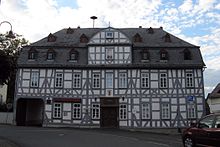Kirberg Office
The Kirberg office (from 1812: Oberamt Kirberg ) was a Nassau office with its seat in Kirberg (from 1812: Camberg ). However, the office was under two separate lines of the House of Nassau , namely Nassau-Saarbrücken and Nassau-Dillenburg and was therefore a condominium .
history
In the old kingdom
In the 14th century, the Nauheim district court existed as part of the County of Diez . In 1355 the Counts of Diez pledged half of the office to Nassau-Merenberg . From this point on, the office was dual . The Nassau-Merenberger share was transferred to Nassau-Saarbrücken.
With the death of the last Count von Diez, Gerhard VII, his son-in-law, Count Adolf von Nassau-Dillenburg, inherited the Diez half of the Kirberg office through his daughter Jutta in 1386 . After he died in 1420 without male descendants, Nassau-Dillenburg and Eppstein each became a quarter owner of the office. In a review of 1423 it was agreed that Eppstein should cede his quarter to Nassau-Dillenburg, whereby the office belonged to Nassau-Saarbrücken and Nassau-Dillenburg in half. This structure existed until the end of the HRR (whereby the Nassau-Saarbrücken part came to Nassau-Usingen by division ).
Due to the two gentlemen of the office, the position of bailiff was also occupied twice. In addition to the Nassau-Usinger, there was also a Nassau-Dillenburg bailiff.
In 1777 the "master builder" was introduced by contract between the two sovereigns. This meant that the chairmanship of the official meetings alternated between the two officials annually. Orders and judgments still required both signatures.
In the Duchy of Nassau
After the establishment of the Rhine Confederation in 1806, Nassau-Oranien (as Nassau-Dillenburg called itself at that time) had to hand over half of it to Nassau-Weilburg at the Kirberg office. Nassau-Weilburg and Nassau-Usingen merged to form the Duchy of Nassau . This ended after many centuries the dual power.
This also eliminated the need to employ two officials. Ernst Cornelius Pagenstecher became the sole bailiff in Kirberg.
In 1812 the neighboring offices of Amt Camberg , Amt Dauborn and Amt Kirberg were merged. The seat of the new Oberamt Kirberg was in Camberg . The previous bailiff Pagenstecher retired and the previous Camberg bailiff Friedrich August Freiherr Schütz von Holzhausen was now responsible for the larger office.
Orange Intermezzo
With the state treaty of July 14, 1814, the former Orange places were returned to the re-established Nassau-Orange. From the Oberamt Kirberg only Dombach, Haintchen, Oberselters and Schwickenhausen remained with the Duchy. The handover that took place in August 1814 was reversed on May 31, 1815. These places fell to Prussia , which passed them on directly to the Duchy of Nassau.
The end of the office
With the administrative reform of the Minister of State Carl Friedrich Emil von Ibell in 1816 came the end of the senior office in Kirberg. It was dissolved and distributed to the offices of Idstein and Limburg , and the office of Usingen was given Haintchen .
area
In the old empire, the Kirberg office included the places Heringen , Kirberg , Nauheim , Neesbach , ears and Mensfelden .
After the merger with the Office Camberg and the Office Dauborn to form the Oberamt Kirberg, the Oberamt consisted of the following locations:
| Dauborn Office | Kirberg Office | Camberg Office |
|---|---|---|
| Dauborn | Herrings | Camberg |
| Eufingen | Kirberg | Dombach |
| New hostel | Nauheim | Erbach |
| Gnadenthal farm | Neesbach | Haintchen |
| Yard at home | Ears | Oberselters |
| Mensfelden | Schwickershausen | |
| Choke |
Office building
The official seat was initially in the old town hall of the town. A Nassau-Oranisches Amtshaus burned down in 1710 and was initially not replaced. In 1771 a new office building was built on the old site. This building was later the Nassauische Kellerei and then the "zur Post" inn.
Personalities
Bailiffs
Nassau-Dillenburg
- Georg Friedlieb Rühle (1711–1768)
- Ernst Cornelius Pagenstecher (1768–1808)
- Friedrich Reinhard Helmrich (-1816)
Duchy of Nassau
- Ernst Cornelius Pagenstecher (1806–1812)
- Friedrich August Freiherr Schütz von Holzhausen (1812-)
- Helmrich (-1816) then bailiff in Herborn
Other
- Anton Hoen , cellar from 1585
Individual evidence
- ↑ Wilhelm von der Nahmer: Handbuch des Rheinischen Particular-Rechts: Development of the territorial and constitutional relations of the German states on both banks of the Rhine: from the first beginning of the French Revolution up to the most recent times . tape 3 . Sauerländer, Frankfurt am Main 1832, OCLC 165696316 , p. 153 f . ( Online at google books ).
- ↑ Ulrich Lange: EC Pagenstecher - his family and the end of both offices, 1988, ISBN 3-87460-064-5 , p. 25
- ^ Norbert Zabel: Spatial authority organization in the Duchy of Nassau 1806-1866, 1981. ISBN 3-922244-39-4 , p. 38
- ↑ Ulrich Lange: EC Pagenstecher - his family and the end of both offices, 1988, ISBN 3-87460-064-5 , p. 30
